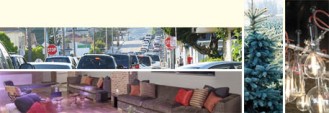Favorite Architecture and Urbanism Blog Posts for Week of Dec. 3, 2012

Luckett and Farley on the importance of office design. Lake|Flato reflects history in custom lighting. Geoff Manaugh on pop-up forestry. Kaid Benfield on making cities more walkable.
Importance of office design. William J. (Billy) Hallisky blogs about the art of designing a modern office and why design still matters.
The well-designed adaptive re-use of a corporate interior can play a pivotal role in a business’ success. The right design, for example, might require a large capital investment, but is easily offset when spectacular reductions are made in revenue wasted on space that no longer fits a company’s business model (or more often than not, re-designing a poorly designed space).
Custom lights are remnants of history. Phil Zimmerman, intern at Lake Flato, blogs about the installation of custom light fixtures at the nearly completed Pearl Parkway Buildings of the Pearl Brewery Redevelopment in San Antonio, Texas.
The light fixtures were designed to use existing materials and remnants from the historical brewery. The “Beakerlier” was created for a lobby space within one of the Parkway buildings called the Lab. The fixture is composed of materials originally used for beer quality and recipe testing in the Brewery’s lab. The chandelier’s design uses found objects and also references an obscure yet important historical function within the Brewery’s beer making process.
Via The Dogrun
Pop-up forests. Geoff Manaugh of BLDGBLOG discusses an article in the New York Times on Christmas tree research labs, scrutinizing the program’s extreme steps that include “the largest and most sophisticated of operations,” where scientists “harvest almost a million trees a year from an 8,500-acre plantation and remove them by helicopter” for analysis elsewhere.
While the goal of the tree labs is to develop new and improved tree species for both indoor and outdoor display during the holiday season and to create a tree that can last weeks without shedding its needles, Manaugh says the vision of this kind of pop-up forest brings to mind a different kind of pop-up forest, one of “insurgent shrublands,” disturbed landscapes, and other “fast-emerging but short-lived ecosystems in an era of nonlinear climate change.”
Via BLDGBLOG
Making cities more walkable. Kaid Benfield discusses the 10 keys to creating walkability in a city from Jeff Speck’s new book Walkable City.
Speck’s ten steps of walkability:
- Put cars in their place. (“Traffic studies are bullshit.”)
- Mix the uses. (“Cities were created to bring things together.”)
- Get the parking right. (“Ample parking encourages driving that would not otherwise occur without it.”)
- Let transit work. (“While walkability benefits from good transit, good transit relies absolutely on walkability.”)
- Protect the pedestrian. (“The safest roads are those that feel the least safe.”)
- Welcome bikes. (“In Amsterdam, a city of 783,000, about 400,000 people are out riding their bikes on any given day.”
- Shape the spaces. (“Get the design right and people will walk in almost any climate.”)
- Plant trees. (“It’s best not to pick favorites in the walkability discussion— every individual point counts— but the humble American street tree might win my vote.”)
- Make friendly and unique [building] faces. (“Pedestrians need to feel safe and comfortable, but they also need to be entertained.”)
10. Pick your winners. (“Where can spending the least money make the most difference?”)
